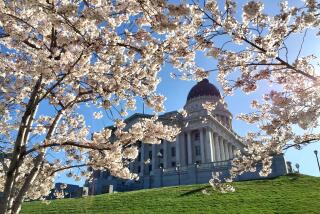Review: Lewis Baltz photographs development in Park City, Utah
- Share via
“Ideally,” Lewis Baltz wrote in commentary accompanying the early publication of some of his 1978-79 pictures of Park City, Utah, “the photographer should be invisible and the medium transparent.”
That aspiration was common enough among New Topographics photographers in the ‘70s, but also slyly disingenuous. If those framing the shots and pressing the shutters were truly invisible, a picture by Baltz wouldn’t be instantly recognizable, nor distinguishable from one by Robert Adams or Joe Deal. Baltz’s pictures are crisp from edge to edge, unsentimental in their subject matter and seemingly neutral in approach. They are dense with information, and information is never delivered without a slant.
Baltz considered the 102 pictures that constitute his Park City series -- on view at Gallery Luisotti, courtesy of UC Riverside’s California Museum of Photography -- as a single unit. The small, black and white prints are installed three deep in a continuous band that stretches across two walls.
Relatively dry and factual yet interesting, the images read as an essay that argues implicitly against the aesthetic and environmental offenses committed during Park City’s development boom of the late ‘70s. Baltz starts out pairing distant mountain ranges with nearer heaps of rubble and debris from new housing construction and the area’s former function as a mining dump.
About two-thirds of the way through, he shifts to photographing interiors of the unfinished homes. The compositions of drywall, framing and wiring are spare as ever, but more than a few possess the minimalist elegance and luminous beauty that also pulse through Baltz’s self-avowedly bloodless work.
Gallery Luisotti, Bergamot Station 2525 Michigan Ave., Santa Monica, (310) 453-0043, through July 28. Closed Sunday and Monday. www.artnet.com/luisotti.html
More to Read
The biggest entertainment stories
Get our big stories about Hollywood, film, television, music, arts, culture and more right in your inbox as soon as they publish.
You may occasionally receive promotional content from the Los Angeles Times.










